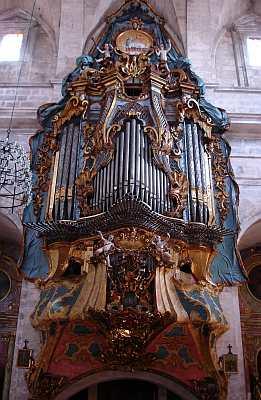Francis
Chapelet

Francis
Chapelet is a French organist, born in 1934 in Paris. He studied at
Higher National Academy of Music and Dance of Paris with Maurice
Duruflé as his professor
in organ and improvisation.
Francis
is known to be one of the foremost authorities on the Iberian organ
and directed the Internation Academy of the Iberian Organ of
Castille. Also, he is an international concert performer, and his
talents of improvisation are recognized throughout the world.
His
discography is extensive, and includes many recordings of Iberian and
French organs.
Francis
Links:
The
Unofficial
Francis
Chapelet Fan Club. - Many nice pictures.
Frédéric
Deschamps
has taken many videos
of Francis. Watch with Gnash.
Francis
visits
a
Dom Bedos organ.
About
the
organ in Francis Chapelet's house.
About
the Iberian Organ:
A
micro-essay by Luke P. Patmore

The
Spanish organ is perhaps the school of organbuilding that is the most
forgotten and the least appreciated (sometimes rightly so). The
image above is of the Santanyi organ in Mallorca (1762). One may
note its monumental and splendidly decorated facade (by Fra Albert
Borguny). This facade reflects the imperial pomposity of the time,
which adds so much to the brilliance and brightness of this organs
registers.
This
organ is an archetype of the Spanish school of organbuilding. Note
the nine ranks of horizontal reed pipes, which compose the
trompeteria. Fanned, they spread sound to every corner of the
church.
The
Santanyi organ is the instrument with the largest mixture stop in the
world, having twenty-five rank and 1,104 pipes!
The
Iberian organ has many characteristic stops:
- Flautat 8'
- The basic unstopped flue tone;
corresponds to the "principal" in the rest of Europe (or the French
"montre"), not to the "flutes."
- Octava 4'
- 4' version of the Flautat; cf. the
French Prestant.
- Bordó
- Stopped Flautat, but only
partially stopped, like a German Rohrgedeckt.
- Tapadet 4'
- 4' version of the Bordó.
- Flautat major 16'
- Sources recommend using this by
itself or in any combination with the 8' flautat and/or either of the
4' flues, but not the 8' bordó.
- Flautes dobles 8'
- A gentle beating stop. Used for
slow moving pieces such as Tientos de Falsas. In the Mass, may be used
for the Elevation. (Perhaps it can be combined with the Temblor to
produce sea-sickness.)
- Nasards
- A compound stop consisting of a
nasard (flute 2 2/3') plus other stops that would otherwise have to be
drawn individually with it. (Sources usually use the singular "nasard"
for the single stop, and the plural for a compound stop.) Can be used
for a left hand solo, against a flue registraton (probably 8' only) in
the right hand. It can also be used as bass against the treble cornet
for pieces that have four moving parts. Optionally can be drawn with
Flautat Major 16', or either 8' (but not both), or 16' + Flautat 8'.
The registrations with 16' are presumably not good for solo use.
- Corneta Magna
- Used either as a right hand solo
stop against an 8' bass registration (either flue, or the Trompa
Batalla 8' with optional Clarins in 15ª), or with the Nasards in
four-part music with moving parts. Can be drawn with the following
stops: Flautat 8', Tapadet 4', or either 8' plus either 4' (only one of
each).
And the
characteristic reed stops:
- Trompa Batalla 8'
- Can be used by itself in both
hands or with Bordó 8'. Like all reeds, this gets noticeably weaker in
the treble, which may have to be reinforced with another reed, probably
the Trompa Magna 16', the Clarins 8', the Xirimia Alta 4', or any
combination of these. The Trompa Batalla 8' also be used as a solo,
especially in the right hand, against a flue or Ple registration (but
probably should be reinforced against the Ple.
- Trompa reial 8'
- An interior reed, and more evenly
voiced than the exterior reeds. Can be used as a solo in either hand
against a flue registration. Can be combined with 8' and/or 4' flues
(some sources say only the stopped flues, not the open ones).
Historically, it is unclear whether this was part of a reed chorus; my
own preference is not to combine it with other reeds (although it could
certainly dialog against them).
- Baixons 4'
- As a solo, against an 8' (flue or
reed) registration in the right hand Also reinforces the Trompa Batalla
8' in a reed chorus.
- Trompa Magna 16'
- As a solo, against an 8' (flue or
reed) registration in the left hand Also reinforces the Trompa Batalla
8' and/or Clarins 8' in a reed chorus
- Clarins en 15ª 2'
- As a solo, against an 8' (flue or
reed) or 4' (reed) registration in the right hand Also reinforces the
Trompa Batalla 8' in a reed chorus.
- Clarins 8'
- Exactly the same uses as the
Trompa Batalla 8'.
Historical
registration on this organ is a long forgotten art remembered by few
scholars. Common sense says that the Ple on the Santanyi organ was
not something to be over-used. For the Ple, certain historical
documentation about the Santanyi organ state that it should not be
drawn with too many other stops to avoid taxing the wind supply (more
so when it was hand-blown). Under no circumstances should the Ple be
combined with reeds, only used against them. Should the Ple ever be
combined with reeds, the church would have been shook to the ground
quite violently, crushing the organist, clergy, and congregation.
Furthermore, using the Ple with the Nasards, Corneta, or any reeds
results in automatic excommunication of the organist.
It
is advisable to keep registration conservative but not static.
To
conclude, it is best to mention that author G.A. Audsley regardeded
Iberian reeds “big and noisy” but not musical. Use them sparingly and
the congregation will appreciate it more when
you do.
Remember:
be safe, don't
drink and register Iberian organs.
Home
again?

